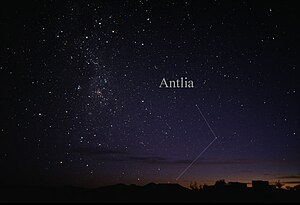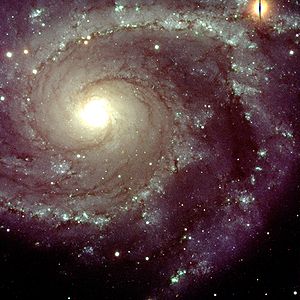唧筒座
| 星座 | |
 | |
| 缩写 | Ant. |
|---|---|
| 所有格 | Antliae |
| 象征物 | 气泵[1] |
| 赤经 | 09h 27m 05.1837s–11h 05m 55.0471s[2] |
| 赤纬 | -24.5425186°– -40.4246216°[2] |
| 家族 | 拉卡伊 |
| 面积 | 239平方度 (第62位) |
| 主要恒星 | 3 |
| 拜耳/佛氏 恒星 | 9 |
| 有行星的恒星 | 2 |
| 亮度3m以上的恒星 | 0 |
| 距离在10秒差距(32.62光年)内的恒星 | 2 |
| 最亮星 | 唧筒座α (+4.25m) |
| 最近的恒星 | DEN 1048-3956[3] (13.17 ly, 4.04 pc) |
| 梅西尔天体 | 0 |
| 流星雨 | 无 |
| 邻接星座 | 长蛇座 罗盘座 船帆座 半人马座 |
| 可以看见的纬度范围: +45°至−90°之间 | |
唧筒座(英语:Antlia)是南天星座之一。拉丁语义“泵”;代表气泵。星座于18世纪经尼古拉·路易·拉卡伊创立,原名为“Antlia Pneumatica”,后由约翰·赫歇尔缩减成现在的名称。唧筒座所在位置靠近旧星座南船座,唧筒座在北纬49度线以南可视全貌。
唧筒座光芒黯淡,最亮的恒星是疑似变星的橘色巨星唧筒座α,视星等为4.22至4.29。唧筒座S属交食双星系统,其亮度会因其中一颗星在另一颗星前方通过而变化。两颗星的距离非常近,拥有共有包层,所以之后必将融合成一颗。唧筒座内已确知HD 93083和WASP-66存在系外行星,此外星座内还有螺旋星系NGC 2997和唧筒座矮星系。
历史
[编辑]
法国天文学家尼古拉·路易·拉卡伊在1751年至52年间最早使用法语“la Machine Pneumatique”(气动泵)一词来描述这个星座[4][5],用意是纪念法国物理学家丹尼斯·帕潘所发明的气泵[6]。拉卡伊于在好望角逗留的两年间观察了差不多一万颗南天恒星,并把它们分类,还为欧洲不能观察到的南半天球未开发区域创造了14个星座。除了一个以外他都用象征欧洲启蒙时代的各种仪器来命名[a][7]。拉卡伊于1763年在他的星图上把星座的名字拉丁化成“Antlia pneumatica”。英国天文学家约翰·赫歇尔于1844年提出将二字的拉丁文名称缩减成一字,并指出拉卡伊本人有时也会使用自己星座的简称[8]。这项提议获得了普遍采用[9]。国际天文联会于1922年正式通过唧筒座成为现代88星座之一[10]。
古希腊人虽然因为唧筒座的恒星高于水平线而可以观察到它们,但是它们实在太黯淡了,因此并没有被归入任何的古代星座里[6]。现时组成唧筒座的恒星位于由古代星座南船座所覆盖的区域,南船座所代表的是希腊神话中阿尔戈英雄的船阿尔戈号,但是由于南船座实在太巨大了,因此拉卡伊在1763年把它分割成数个较小的星座[11][12]。伊恩·里德帕夫在报告中指出由于唧筒座恒星的亮度都太低,因此它们不是南船座古典描述的一部份[13]。
东方天文学
[编辑]中国天文学家能够在他们的纬度观察到在现代属于唧筒座的恒星,并把它们归给两个不同的星宿。唧筒座南部的数颗恒星属于翼宿的星官“东瓯”,代表中国南方的古国[6]。而唧筒座ε、η和θ则属于张宿的星官“天庙”,而天庙同时也包含现代罗盘座的恒星[6]。
总体特点
[编辑]唧筒座的面积为238.9平方度,因此占全天球的0.59%,面积上在现代88星座中位列第62名[14]。它在南天的位置使得北纬49度线以南的人都能观看整个星座[14][b]。长蛇座占据整个唧筒座的北部边界,而罗盘座、船帆座和半人马座分别位于唧筒座的西、南、东边。由国际天文联会所采纳的唧筒座三字母缩写为Ant[10]。正式的星座边界由比利时天文学家尤金·德尔波特于1930年制定[c],形状是十二边的多边形(见右上资料盒的附图)。这些边界位处赤道坐标系统的赤经坐标09h 26.5m至11h 05.6m之间,以及赤纬坐标−24.54°至−40.42°之间[2]。
细节特征
[编辑]恒星
[编辑]
拉卡伊以拜耳命名法把α到θ分配了给9颗恒星,其中两颗邻近的恒星同时以ζ为名。本杰明·阿普索普·古尔德后来添加了以ι命名的第10颗恒星。唧筒座β和γ(今HR 4339和HD 90156)于1930年边界勾划时被归入了一旁的长蛇座[16]。在唧筒座的边界内共有42颗恒星的视星等亮于或等于6.5[d][14]。 唧筒座最亮的两颗星唧筒座α和ε的光芒中都带有少许红色[18]。唧筒座α(中名近天纪增二)是一颗橘色的巨星,其恒星光谱分类为K4III,并疑似是一颗变星,亮度介乎4.22至4.29之间[19]。离地球的距离为370±20光年[20]。估计它的光度为太阳的480至555倍,它最有可能是一颗的正在衰老的恒星,现时在增亮的过程中,准备在所有核心燃料都转化成碳后变成一颗米拉变星[21]。唧筒座ε离地球的距离为710±40光年[20],它的光谱型为K3IIIa,是一颗零龄主序后的橘色巨星,膨胀后的半径为太阳半径的69倍[22],光度相等于约1,279个太阳[23]。它的亮度有着轻微的变化[24]。唧筒座ι在唧筒座的另一端,它也是一颗橘色的巨星,光谱型为K1III[25]。
唧筒座δ是一组联星,位于唧筒座α附近,距地球430±30光年[20]。主星是一颗蓝白色的主序星,光谱型为B9.5V,视星等为5.6;而伴星则是一颗光谱型为F9Ve恒星,视星等为9.6黄白色的主序星,[26]。唧筒座ζ是一组远距光学双星。其中较亮的唧筒座ζ1距地球410±40光年,视星等为5.74[20],是货真价实的一组联星,由两颗白色主序星所组成,它们的视星等分别为6.20和7.01,两者相隔8.042角秒[27]。较暗的唧筒座ζ2则距地球380±20光年[20],视星等为5.9[28]。唧筒座ε也是一组双星,主星为一颗黄白色恒星,光谱型为F1V、视星等为5.31,而伴星的视星等则为11.3[27]。唧筒座θ同样也是一组双星,最有可能是由一颗A型主序星和一颗黄色巨星组成[29]。唧筒座S是一个互食双星系统,它的视星等变化范围为6.27至6.83,变化周期为15.6小时[30]。这个系统被归类为大熊座W型变星,其中主星的温度比伴星高,而视星等的下降是由后者在前者前方通过所引起的。从轨道周期可以计算出成份恒星的性质,计算结果指出主星的质量为太阳的1.94倍,直径则为2.026倍,而伴星的质量为太阳的0.76倍,直径则为1.322倍[31]。由于系统两颗恒星间存在共有包层,能够分享恒星材料,因此两者的光度与光谱类型都相近[32]。天文学家认为这个系统的年龄在50至60亿岁之间。这两颗恒星最终会合而为一,形成一颗高速自转的恒星[31]。
唧筒座T是一颗黄白色的超巨星,光谱型为F6Iab,它也是一颗经典造父变星,视星等变化范围为8.88至9.82,变化周期为5.9天[33]。唧筒座U是一颗红色的C型碳星,它也是一颗不规则变星,视星等变化范围为5.27至6.04[34]。它距地球约900光年,光度约为太阳的5,819倍[23]。唧筒座BF是一颗矮造父变星,它的视星等变化只有0.01[35]。唧筒座AG是一颗不寻常的热变星,它的光谱型为B9.5Ib-II。它正在经历激烈的质量流失[36],它是一颗独一无二的变星,不属于任何已知的变星分类,视星等变化范围由5.29至5.83,变化周期为429天[37]。唧筒座UX是一颗北冕座R型变星,视星等的基准线在11.85左右,它会不规则地变暗,最暗能到18.0以下[38]。它是一颗既光亮又遥远的超巨星,光谱跟黄白色的F型主序星相似,但是它几乎没有氢[39]。

HD 93083是一颗橘色的矮恒星,光谱型为K3V,它比太阳小,温度也比太阳低。它有一颗行星,是由高精度径向速度行星搜索器以径向速度法于2005年发现。行星的大小与土星相若,环绕恒星一周需时137天,轨道平均半径0.477天文单位[40]。WASP-66是一颗像太阳的恒星,光谱型为F4V。它有一颗质量为木星2.3倍的行星,每4天围着它走一圈,这颗行星是在2012年用凌日法发现的[41]。DEN 1048-3956是一颗棕矮星,光谱种类为M8,距地球约13光年。由于视星等17的它实在太黯淡,所以肉眼不能看见。它的表面温度在2,500开尔文左右。天文学家于2002年侦测到两个持续4至5分钟的耀斑[42]2MASS 0939-2448是一个拥有两颗既冷且暗的矮星的系统,有可能它们的有效温度分别约为500和700开尔文,质量约为木星的25和40倍,也有可能它们的温度都在600开尔文,质量都是木星的30倍[43]。
深空天体
[编辑]唧筒座内有不少黯淡的星系[44],其中最亮的是视星等为10.6的NGC 2997[45]。它是一个正面朝向地球且旋臂宽松的螺旋星系,星系分类为Sc。尽管大部份业馀的天文望远镜中都难以区分,但是它在照片上呈现出由年轻恒星组成的明亮星团和不少昏暗的尘埃带[28]。视星等为14.8的唧筒座矮星系于1997年被发现,是一个属于本星系群的矮椭球星系[46]。
唧筒座星系团(又名阿贝尔S0636)是一个位于长蛇-半人马座超星系团的星系团。它是继室女座星系团和天炉座星系团第三接近本星系群的星系团[47]。这星系团离地球的距离为40.5至40.9百万秒差距(132.1至133.4百万光年)[48]。它位于唧筒座的东南角,星系团中最显著的是两个巨大的椭圆星系NGC 3268和NGC 3258,两者分别是南部子团和北部子团的主要星系,而整个星系团共有星系234个[44]。
参考资料
[编辑]注释
[编辑]引用
[编辑]- ^ Bakich, Michael E. The Cambridge Guide to the Constellations. Cambridge, United Kingdom: Cambridge University Press. 1995. ISBN 978-0-521-44921-2.
- ^ 2.0 2.1 2.2 Antlia, constellation boundary. The Constellations (International Astronomical Union). [2014-02-14]. (原始内容存档于2013-06-05).
- ^ The 100 Nearest Star Systems. Research Consortium on Nearby Stars. 2012-01-01 [2016-05-02]. (原始内容存档于2012-07-31).
- ^ Ridpath, Ian. Lacaille's Southern Planisphere of 1756. Star Tales. Self-published. [2015-08-25]. (原始内容存档于2016-03-04).
- ^ Lacaille, Nicolas Louis. Relation abrégée du Voyage fait par ordre du Roi au cap de Bonne-espérance. Mémoires de l'Académie Royale des Sciences. 1756: 519–592 [589] [2016-07-31]. (原始内容存档于2021-01-05) (法语).
- ^ 6.0 6.1 6.2 6.3 Ridpath, Ian. Antlia. Star Tales. [2007-12-03]. (原始内容存档于2020-09-15).
- ^ 7.0 7.1 Wagman 2003,第5–6页.
- ^ Herschel, John. Farther Remarks on the Division of Southern Constellations. Monthly Notices of the Royal Astronomical Society. 1844, 6 (5): 60–62 [2016-07-31]. (原始内容存档于2021-01-10).
- ^ Wagman 2003,第25页.
- ^ 10.0 10.1 Russell, Henry Norris. The New International Symbols for the Constellations. Popular Astronomy. 1922, 30: 469. Bibcode:1922PA.....30..469R.
- ^ Birren, Peter. Objects in the Heavens. Bloomington, Indiana: Trafford Publishing. 2002: 9, 45. ISBN 1-55369-662-X.
- ^ Webb, Thomas William. Celestial objects for common telescopes 2. New York, New York: Dover Publications. 1962: 36. ISBN 978-0-486-20918-0.
- ^ Ridpath, Ian. Stars and Planets. New York, New York: Smithsonian Handbooks. 2002: 65, 122. ISBN 0-7894-8988-0.
- ^ 14.0 14.1 14.2 14.3 Ridpath, Ian. Constellations: Andromeda–Indus. Star Tales. self-published. [2015-08-26]. (原始内容存档于2019-03-24).
- ^ Ridpath, Ian. Constellation boundaries: How the modern constellation outlines came to be. Star Tales. self-published. [2016-06-01]. (原始内容存档于2019-03-24).
- ^ Wagman 2003,第29页.
- ^ Bortle, John E. The Bortle Dark-Sky Scale. Sky & Telescope. 2001 [2015-08-26]. (原始内容存档于2014-03-31).
- ^ Arnold, H.J.P; Doherty, Paul; Moore, Patrick. The Photographic Atlas of the Stars. Boca Raton, Florida: CRC Press. 1999: 97 [2016-07-31]. ISBN 978-0-7503-0654-6. (原始内容存档于2021-01-05).
- ^ Watson, Christopher. Alpha Antliae. AAVSO Website. American Association of Variable Star Observers. 2010-01-18 [2014-07-25]. (原始内容存档于2021-01-05).
- ^ 20.0 20.1 20.2 20.3 20.4 van Leeuwen, F. Validation of the new Hipparcos reduction. Astronomy and Astrophysics. 2007, 474 (2): 653–64 [2016-07-31]. Bibcode:2007A&A...474..653V. arXiv:0708.1752
 . doi:10.1051/0004-6361:20078357. (原始内容存档于2016-04-02).
. doi:10.1051/0004-6361:20078357. (原始内容存档于2016-04-02).
- ^ Kaler, James B. Alpha Antliae. Stars. University of Illinois. [2014-07-25]. (原始内容存档于2020-05-22).
- ^ Pasinetti-Fracassini, L.E.; Pastori, L.; Covino, S.; Pozzi, A. Catalogue of Stellar Diameters (CADARS). Astronomy and Astrophysics. 2001, 367: 521–24. Bibcode:2001A&A...367..521P. arXiv:astro-ph/0012289
 . doi:10.1051/0004-6361:20000451.
. doi:10.1051/0004-6361:20000451.
- ^ 23.0 23.1 McDonald, I.; Zijlstra, A. A.; Boyer, M. L. Fundamental Parameters and Infrared Excesses of Hipparcos Stars. Monthly Notices of the Royal Astronomical Society. 2012, 427 (1): 343–57. Bibcode:2012MNRAS.427..343M. arXiv:1208.2037
 . doi:10.1111/j.1365-2966.2012.21873.x.
. doi:10.1111/j.1365-2966.2012.21873.x.
- ^ Koen, Chris; Eyer, Laurent. New Periodic Variables from the Hipparcos Epoch Photometry. Monthly Notices of the Royal Astronomical Society. 2002, 331 (1): 45–59. Bibcode:2002MNRAS.331...45K. arXiv:astro-ph/0112194
 . doi:10.1046/j.1365-8711.2002.05150.x.
. doi:10.1046/j.1365-8711.2002.05150.x.
- ^ Iota Antliae. SIMBAD Astronomical Database. Centre de Données astronomiques de Strasbourg. [2014-07-29]. (原始内容存档于2021-01-05).
- ^ Huélamo, N.; Neuhäuser, R.; Stelzer, B.; Supper, R.; Zinnecker, H. X-ray emission from Lindroos binary systems. Astronomy & Astrophysics. 2000, 359: 227–41. Bibcode:2000A&A...359..227H. arXiv:astro-ph/0005348
 .
.
- ^ 27.0 27.1 Eggleton, P. P.; Tokovinin, A. A. A catalogue of multiplicity among bright stellar systems. Monthly Notices of the Royal Astronomical Society. 2008, 389 (2): 869–79. Bibcode:2008MNRAS.389..869E. arXiv:0806.2878
 . doi:10.1111/j.1365-2966.2008.13596.x.
. doi:10.1111/j.1365-2966.2008.13596.x.
- ^ 28.0 28.1 Ridpath 2001,第74–76页
- ^ Kaler, James B. Theta Antliae. Stars. University of Illinois. 2013-04-12 [2016-03-25]. (原始内容存档于2021-01-05).
- ^ Watson, Christopher. S Antliae. AAVSO Website. American Association of Variable Star Observers. 2010-01-04 [2014-05-22]. (原始内容存档于2021-01-05).
- ^ 31.0 31.1 Gazeas, K.; Stȩpień, K. Angular momentum and mass evolution of contact binaries. Monthly Notices of the Royal Astronomical Society. 2008, 390 (4): 1577–86. Bibcode:2008MNRAS.390.1577G. arXiv:0803.0212
 . doi:10.1111/j.1365-2966.2008.13844.x.
. doi:10.1111/j.1365-2966.2008.13844.x.
- ^ Csizmadia, Sz.; Klagyivik, P. On the properties of contact binary stars. Astronomy and Astrophysics. 2004, 426: 1001–05. Bibcode:2004A&A...426.1001C. arXiv:astro-ph/0408049
 . doi:10.1051/0004-6361:20040430.
. doi:10.1051/0004-6361:20040430.
- ^ Watson, Christopher. T Antliae. AAVSO Website. American Association of Variable Star Observers. 2010-01-04 [2014-07-25]. (原始内容存档于2021-01-05).
- ^ Otero, Sebastian. U Antliae. AAVSO Website. American Association of Variable Star Observers. 2011-11-03 [2014-07-25]. (原始内容存档于2017-11-07).
- ^ Chang, S.-W.; Protopapas, P.; Kim, D.-W.; Byun, Y.-I. Statistical Properties of Galactic δ Scuti Stars: Revisited. The Astronomical Journal. 2013, 145 (5): 10. Bibcode:2013AJ....145..132C. arXiv:1303.1031
 . doi:10.1088/0004-6256/145/5/132. 132.
. doi:10.1088/0004-6256/145/5/132. 132.
- ^ Geballe, T.R.; Noll, K.S.; Whittet, D.C.B.; Waters, L.B.F.M. Unusual features of the 1–4 micron spectrum of HR 4049. The Astrophysical Journal. 1989, 340: L29. Bibcode:1989ApJ...340L..29G. doi:10.1086/185431.
- ^ VSX. AG Antliae. The International Variable Star Index. American Association of Variable Star Observers. 2010-01-04 [2013-06-15]. (原始内容存档于2021-01-05).
- ^ Otero, Sebastian. UX Ant. The International Variable Star Index. 2012-11-23 [2014-07-14]. (原始内容存档于2021-01-05).
- ^ Kilkenny, D.; Westerhuys, J. E. Spectroscopy of 'RCB' stars-IV. UX ANT. The Observatory. 1990, 110: 90–92. Bibcode:1990Obs...110...90K.
- ^ Lovis, C.; Mayor, M.; Bouchy, F.; Pepe, F.; Queloz, D.; Santos, N.C.; Udry, S.; Benz, W.; Bertaux, J.-L.; Mordasini, C.; Sivan, J.-P. The HARPS search for southern extra-solar planets III. Three Saturn-mass planets around HD 93083, HD 101930 and HD 102117. Astronomy and Astrophysics. 2005, 437 (3): 1121–26 [2016-07-31]. Bibcode:2005A&A...437.1121L. arXiv:astro-ph/0503660
 . doi:10.1051/0004-6361:20052864. (原始内容存档于2019-05-17).
. doi:10.1051/0004-6361:20052864. (原始内容存档于2019-05-17).
- ^ Hellier, Coel; Anderson, D. R.; Collier Cameron, A.; Doyle, A. P.; Fumel, A.; Gillon, M.; Jehin, E.; Lendl, M.; Maxted, P. F. L.; Pepe, F.; Pollacco, D.; Queloz, D.; Ségransan, D.; Smalley, B.; Smith, A. M. S.; Southworth, J.; Triaud, A. H. M. J.; Udry, S.; West, R. G. Seven transiting hot Jupiters from WASP-South, Euler and TRAPPIST: WASP-47b, WASP-55b, WASP-61b, WASP-62b, WASP-63b, WASP-66b and WASP-67b. Monthly Notices of the Royal Astronomical Society. 2012, 426 (1): 439–50. Bibcode:2012MNRAS.426..739H. arXiv:1204.5095
 . doi:10.1111/j.1365-2966.2012.21780.x.
. doi:10.1111/j.1365-2966.2012.21780.x.
- ^ Burgasser, Adam J.; Putman, Mary E. Quiescent Radio Emission from Southern Late-Type M Dwarfs and a Spectacular Radio Flare from the M8 Dwarf DENIS 1048–3956. The Astrophysical Journal. 2005-06-10, 626 (1): 486–497 [2016-07-31]. Bibcode:2005ApJ...626..486B. arXiv:astro-ph/0502365
 . doi:10.1086/429788. (原始内容存档于2020-09-18).
. doi:10.1086/429788. (原始内容存档于2020-09-18).
- ^ Leggett, S. K.; Cushing, Michael C.; Saumon, D.; Marley, M. S.; Roellig, T. L.; Warren, S. J.; Burningham, Ben; Jones, H. R. A.; Kirkpatrick, J. D.; Lodieu, N.; Lucas, P. W.; Mainzer, A. K.; Martín, E. L.; McCaughrean, M. J.; Pinfield, D. J.; Sloan, G. C.; Smart, R. L.; Tamura, M.; Van Cleve, J. The Physical Properties of Four ~600 K T Dwarfs. The Astrophysical Journal. 2009, 695 (2): 1517–1526. Bibcode:2009ApJ...695.1517L. arXiv:0901.4093
 . doi:10.1088/0004-637X/695/2/1517.
. doi:10.1088/0004-637X/695/2/1517.
- ^ 44.0 44.1 Streicher, Magda. Deepsky Delights: Antlia, the Machine Pneumatique. Monthly Notes of the Astronomical Society of Southern Africa. 2010, 69 (5–6): 107–12. Bibcode:2010MNSSA..69..107S.
- ^ Moore & Tirion 1997
- ^ Nemiroff, Robert. Antlia: A New Galactic Neighbor. Astronomy Picture of the Day. 1997-04-23 [2012-04-09]. (原始内容存档于2011-01-16).
- ^ Smith Castelli, Analía V.; Bassino, Lilia P.; Richtler, Tom; Cellone, Sergio A.; Aruta, Cristian; Infante, Leopoldo. Galaxy populations in the Antlia cluster – I. Photometric properties of early-type galaxies. Monthly Notices of the Royal Astronomical Society. 2008, 386 (4): 2311–22 [2016-07-31]. Bibcode:2008MNRAS.386.2311S. arXiv:0803.1630
 . doi:10.1111/j.1365-2966.2008.13211.x. (原始内容存档于2017-07-02).
. doi:10.1111/j.1365-2966.2008.13211.x. (原始内容存档于2017-07-02).
- ^ Dirsch, B.; Richtler, T.; Bassino, L.P. The globular cluster systems of NGC 3258 and NGC 3268 in the Antlia cluster. Astronomy and Astrophysics. 2003, 408: 929–39 [2016-07-31]. Bibcode:2003A&A...408..929D. arXiv:astro-ph/0307200
 . doi:10.1051/0004-6361:20031027. (原始内容存档于2017-11-09).
. doi:10.1051/0004-6361:20031027. (原始内容存档于2017-11-09).
参考来源
[编辑]- Moore, Patrick; Tirion, Wil, Cambridge Guide to Stars and Planets 2nd, Cambridge University Press, 1997, ISBN 0-521-58582-1
- Ridpath, Ian, Stars and Planets Guide, Princeton University Press, 2001, ISBN 0-691-08913-2
- Wagman, Morton. Lost Stars: Lost, Missing and Troublesome Stars from the Catalogues of Johannes Bayer, Nicholas Louis de Lacaille, John Flamsteed, and Sundry Others. Blacksburg, VA: The McDonald & Woodward Publishing Company. 2003. ISBN 978-0-939923-78-6.
